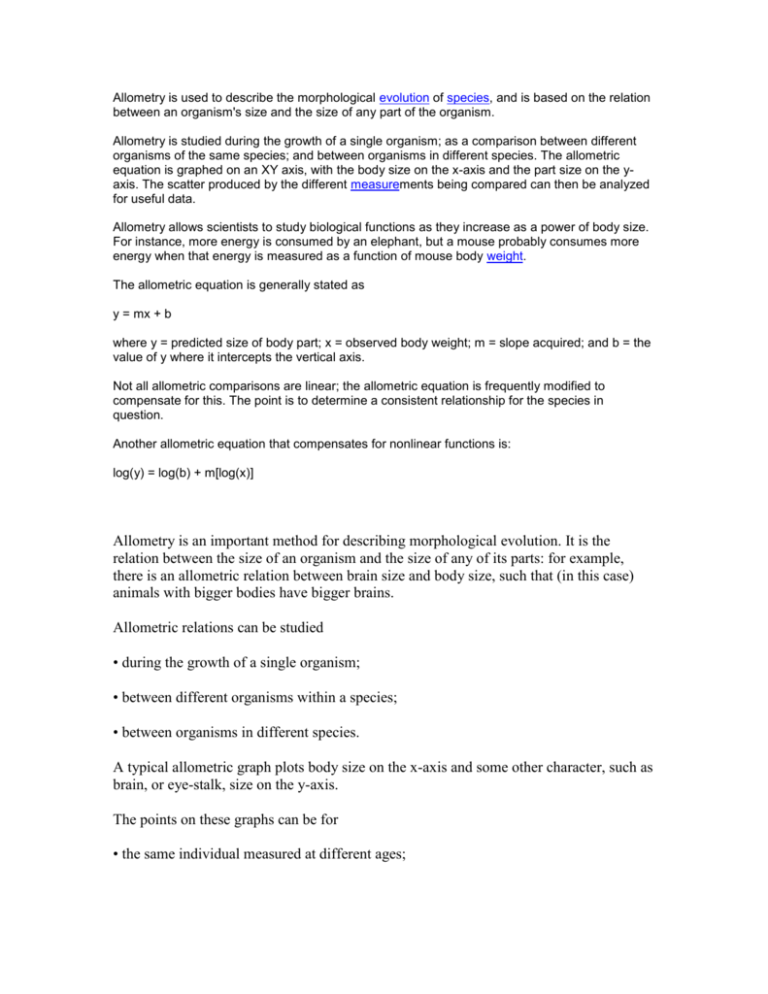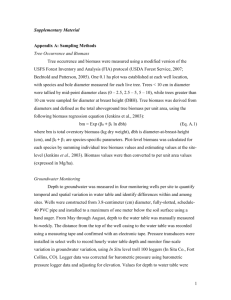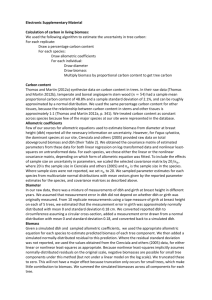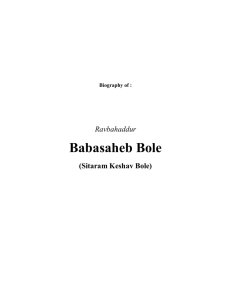Allometry is used to describe the morphological evolution of species
advertisement

Allometry is used to describe the morphological evolution of species, and is based on the relation between an organism's size and the size of any part of the organism. Allometry is studied during the growth of a single organism; as a comparison between different organisms of the same species; and between organisms in different species. The allometric equation is graphed on an XY axis, with the body size on the x-axis and the part size on the yaxis. The scatter produced by the different measurements being compared can then be analyzed for useful data. Allometry allows scientists to study biological functions as they increase as a power of body size. For instance, more energy is consumed by an elephant, but a mouse probably consumes more energy when that energy is measured as a function of mouse body weight. The allometric equation is generally stated as y = mx + b where y = predicted size of body part; x = observed body weight; m = slope acquired; and b = the value of y where it intercepts the vertical axis. Not all allometric comparisons are linear; the allometric equation is frequently modified to compensate for this. The point is to determine a consistent relationship for the species in question. Another allometric equation that compensates for nonlinear functions is: log(y) = log(b) + m[log(x)] Allometry is an important method for describing morphological evolution. It is the relation between the size of an organism and the size of any of its parts: for example, there is an allometric relation between brain size and body size, such that (in this case) animals with bigger bodies have bigger brains. Allometric relations can be studied • during the growth of a single organism; • between different organisms within a species; • between organisms in different species. A typical allometric graph plots body size on the x-axis and some other character, such as brain, or eye-stalk, size on the y-axis. The points on these graphs can be for • the same individual measured at different ages; • for different individuals of a species (in which case the scatter will mainly be due to variation in age); • for different species in a higher taxon. What is allometry? Allometry is all about studying the relative sizes of plant parts. Usually, relationships between dbh (diameter at breast height, or 1.37 m up from ground level), tree height, total biomass, leaf weight, etc., are calculated. For example, what we do here is prepare equations (regressions) to calculate the total above-ground biomass of a Sassafras tree in winter (without leaves) as a function of dbh: we are therefore implicitly assuming that biomass is directly related to tree diameter. Allometry is useful because it allows the total biomass of a forest or stand to be estimated, without having to cut down all the trees, take them back to the lab, dry the pieces in an oven, and then weigh all the pieces. Part of our study at Totoket Mountain was to estimate the biomass of the entire forest: click here to jump to that page. How do we do it, anyway? To calculate the total biomass of our Sassafras trees, we had to calculate the weight of the bole the weight of all the branches In case you want to try this at home, here's what we did to each tree! We did it for four trees, of different sizes and shapes, so that our results would be more applicable to "all" sassafras trees. We cut down the tree with a chainsaw. We divided the tree into bole and branches. For the bole: o We cut the bole into 1 m long sections o We weighed all the sections in the field o We cut a 2-3 cm "cookie" off the end of each section o We took the cookies back to the lab o We weighed each cookie (wet weight) o We measured the thickness of each cookie o We measured the "outside bark" diameter of each cookie o We stripped the bark off each cookie o o o o o o o We measured the "inside bark" diameter of each cookie We weighed separately the bark and the wood of each cookie (wet weight) We oven dried the bark and cookie samples (at 80 C, until dry) When everything was dry, we weighed the dry bark and dry wood From these subsamples of each section, we were able to estimate the ovendry weight of each bole section By adding up the oven-dry weight of the bole sections, we estimated the weight of the entire bole (for wood, bark, and total weight) We then estimated a regression line relating tree dbh to total bole biomass For the branches: o We measured the basal diameter and length of all branches on the tree (step A below) o We took three "representative" branches from each tree back to the lab o We put these sample branches in the oven and dried them (at 80 C) o When the branches were dry, we calculated a regression line relating branch diameter to branch weight (step B below) o Based on this relationship, we estimated the dry weight of all the branches on the tree using the basal diameters we measured in the field o To this we added the oven-dry weight of the dead branches (we brought these back to the lab, too) o This allowed us to estimate the total branch dry weight of each tree (step C below) o Then we estimated another regression line, this one relating tree diameter to total branch dry weight (step D below) o Note that the bark and wood of branches was not separated By combining our estimates of bole and branch weights, we calculated the total above-ground biomass of each tree. We then estimated another regression, this one relating tree diameter to total above ground biomass. When we calculated our regression equations, we used a log-log transformation on the data. Rather than make total above ground biomass a function of dbh, we made log10 (total above ground biomass) a function of log10 (dbh). The relationship between the transformed variables is a linear one: we can calculate this regression line much more easily than if we dealt with untransformed data. Another effect that the log transformation has is that it can make large absolute differences appear relatively small: for example, although the difference between 600 kg and 1000 kg is 400 kg, log(600) = 2.78, log (1000) = 3, and the difference of the logs, 0.22, is less than 8%! We arrived at the following equations: Bole biomass: log10 (bole biomass, g) = 2.3904 * log10 (dbh, cm) + 1.8632 Individual branch weight: log10 (branch dry weight, g) = 2.807 * log10 (branch diameter, cm) + 1.4418 Total branch weight: log10 (total branch biomass, g) = 2.5533 * log10 (dbh, cm) + .9020 Total above-ground biomass log10 (bole + branch biomass, g) = 2.3836 * log10 (dbh, cm) + 1.9566 Basic Tree Data As described above, we cut down four sassafras trees on the east slope at Totoket Mountain, North Branford, CT for analysis. Basic data for these four trees are given below. Total height, m Tree age (at base), years Avg. annual radial increment, mm, last 5 years DBH, cm Diameter at base, cm Tree Tree Tree Tree 1 2 3 4 9.1 16.4 14.7 17.2 73.0 77.0 77.0 5.0 6.4 2.0 0.6 0.9 23.4 28.1 11.8 13.9 16.7 21.1 Crown width, widest, m Crown width, narrowest, m Height to lowest live branch, m Estimated bole dry weight, OD kg Estimated total branch dry weight, OD kg (live + dead) Weight dead branches, OD kg Estimated biomass, OD kg (above ground, no leaves) Average bark thickness, cm Bark water content (g H20 / g OD) Wood water content (g H20 / g OD) Bark density, g / cc Wood density, g/cc Total bark weight in bole, OD kg Total wood weight in bole, OD kg 2.0 6.3 1.5 5.9 6.8 7.2 4.7 137.3 3.7 3.5 8.0 27.5 2.6 2.0 7.0 71.2 0.6 32.0 3.2 5.6 0.3 4.9 1.2 2.2 5.4 169.3 30.7 76.7 2.1 31% 59% 0.26 0.42 19.4 117.0 1.1 26% 39% 0.30 0.41 4.7 22.8 1.5 30% 45% 0.24 0.41 10.1 61.1 Note: some data not available for tree 1, because no cookies were taken (the entire tree was brought back to the lab, where the branches and bole were separated and oven-dried). We estimated height-age curves for Trees 2, 3, and 4 by aging the cookies taken at 1 m intervals. In some cases, rot inside the bole prevented an accurate measurement, because rings could not be counted all the way back to age 1. Best-fit curves (third order polynomial equations) suggest that, in the case of Trees 2 and 3, some sort of release has occurred during the last 20 or so years. Tree 2 Tree 3 Tree 4 We also used data collected by previous years' FES 519b classes. This and more can be found in our downloadable data workbook. Estimating total bole weight Click here to see the data for this graph. Estimating bole volume The bole of a tree can be considered as any of a number of three-dimensional solids. Usually, the bole volume is estimated as if it were a cone, a paraboloid, or a neolid (a solid that flares at the base). We found that sassafras is pretty much cone-shaped, as the following graph illustrates. Estimating weight of individual live branches Click here to see the data for this graph. Estimating weight of all branches, live and dead Click here to see the data for this graph. Estimating above-ground biomass of whole tree Click here to see the data for this graph. The graph below is the same as the graph above, except that the log-log transformation has not been carried out. Observe that the best-fit line is no longer linear. Also, note that even though it fits the data very well, the biomass predicted by the equation is rarely exactly what we measured in the lab (the deviation between measured and calculated biomass is greater than 20% for some of the larger diameter trees)! How fast are these trees growing? We measured the average radial growth over the last five years (1996-1992: the 1997 ring was usually impossible to read due to the bark having been removed) for each tree from each cookie (1 m height increments along the bole). Tree 2 appears to have put on more radial growth high in the bole than low in the bole; for Trees 3 and 4, the radial growth changes little with height. By taking the average annual radial growth, multiplying this by five, doubling that (to get the diameter change over the last five years), and then subtracting this value from the measured dbh, we estimated the tree's diameter in 1993. We then put this value into our biomass equation, and approximated the tree's biomass in 1993. The trees appear to have grown by 25-30% over the last five years, as the following table shows. 1998 Biomass 1993 dbh 1998 dbh 1993 Biomass 1998 Biomass % Change (from lab, kg) (cm) (cm) (from eq., kg) (from eq., kg) Tree 2 169.3 21.4 23.4 110.5 136.8 +24% Tree 3 30.7 10.6 11.8 20.6 26.6 +29% Tree 4 76.7 14.9 16.7 46.5 61.1 +31%










